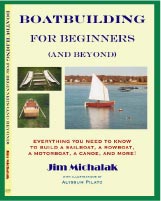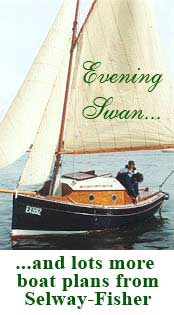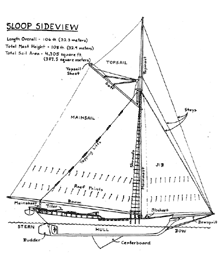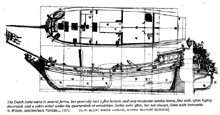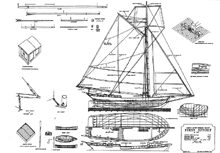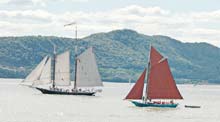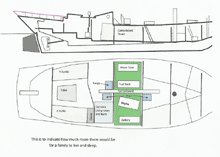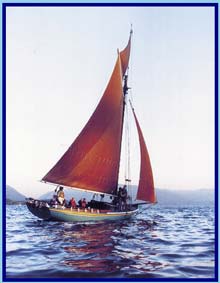
 Custom Search
|
| boat plans |
| canoe/kayak |
| electrical |
| epoxy/supplies |
| fasteners |
| gear |
| gift certificates |
| hardware |
| hatches/deckplates |
| media |
| paint/varnish |
| rope/line |
| rowing/sculling |
| sailmaking |
| sails |
| tools |
| join |
| home |
| indexes |
| classifieds |
| calendar |
| archives |
| about |
| links |
| Join Duckworks Get free newsletter CLICK HERE |
|
|
| Out There |
by Paul Austin - Dallas, Texas - USA The Hudson Sloop |
 |
I've always heard the schooner is the quintessential American rig. We certainly did develop it to a fine degree of speed and beauty. But the schooner is a long deep keeled ship needing a crew and room to maneuver. So I think for a young family on a cruise, for a cheaper boat, one that is easier to manage, with room below without being too big, the Hudson River sloop will do nicely. With one mast, it is manageable in close quarters, with jibs and topsails it can handle light winds and beating to weather decently well, and with its' raised after-deck it has plenty of room below. Today we would add a motor and centerboard. The centerboard can be so close to the mast that it doesn't slice you in half when you walk below. This is the modern version of the Hudson River sloop, named Clearwater. This image was graciously provided to me free of charge by the folks who take care of Clearwater:
Around 1810 the most famous writer in America was Washington Irving. His novels were all the rage. Today nobody reads Irving except English majors who have no choice, as Irving's style is considered ornate to the max. I would say his style is impersonal descriptive excess. But he did leave us with a scene of Governor Peter Stuyvesant sailing up the Hudson River in a sloop. Here it is:
If you can swallow that, you're a better man than I, Gunga Din. But Irving does convey the great natural beauty of the river at that time. This was written in 1810 when the Hudson River already had a long history of sailing. Although he wasn't the first man to see the river's opening to the sea, Henry Hudson sailed the mouth of the river in 1609, exploring for the Dutch East India Company. They were strictly business, looking for trade routes to the Caribbean. Their ship was the de Halve Maen, a deep keeler. What they found along the river was an endless supply of timber, furs, silver, maize and fish everywhere. But as they sailed north, the river shallowed, with shoals below the Maen's keel. They had to stop where Albany is now. Hudson and his crew sailed home that fall, but the Dutch East India Company didn't follow up on what Hudson had discovered. The Dutch did, naming the port, New Amsterdam. A fort was constructed upriver, a settlement came to Manhattan Island by 1615. The Dutch shipwrights who came set up shipbuilding on the river, building the first ship, named Onrust, a 'jacht' built by Adriaen Block. Onrust was used for trade and exploration, returning to Amsterdam in in 1615. The historian H.I. Chapelle says she was 16 tons burden, 38 feet long, with 11 feet of beam (History of American Sailing Ships, Bonanza Books, p. 6). Chapelle guesses she had leeboards, rigged as a one-mast sloop. It may not have had leeboards, since she had to cross the Atlantic. The Dutch could build keel boats as well as anyone, but the one mast may be true since it could be rigged to sail against the wind coming west.
This is not the Onrust, whose lines probably don't exist. The Dutch who came to the New World didn't use lines or even a model. They build what they had been building in Holland. These lines are from a Dutch jacht of 1671, probably 95% of what Onrust looked like:
And that brings up a point historians deal with often. If someone builds a new style of ship in this harbor and someone else builds a ship quite similar in a harbor 100 miles away, the historian can assume one lead to another. But this is rarely true in America. However, with the Dutch jachts of the Hudson River, designs in Holland of the early 1600s actually were the pattern for the first ships build in America. Changes came later due to the sea conditions here, and those changes came slowly at first (Fontenay, Paul, The Sloops of the Hudson River, Mystic Seaport Inc., 1994).
On this side of the Atlantic we sail with with wind or across it, which will ultimately lead to schooners; on the east side of the Atlantic they have to sail against the wind to get into the Channel, so they built sloops with sprit rigs or short gaff rigs with topsails. As a result the Dutch sloop came to America. By 1661 a survey of New York harbor showed 15 ships, all one-mast sloops with a prominent stern cabin, 40-50 feet on deck, and a large staysail set to a bowsprit. This is the pattern for the Hudson River sloops, and it will endure. As the nature of trade and passenger traffic changed, details on the Hudson River sloop changed to keep the ship alive. Centerboards came in to help the shallow straight-keeled sloop sail north of Albany. Hulls were kept wide and shallow for cargo and living space below. The topsails went from square sails to triangular topsails. If you were to look at the midframe you might think the hull was a catboat; if you were to look at the half-breadth view you might think it has the bow of a scow, the traditional river boat. This image is from 1830, named First Effort because it was the first design by James Knowles. These lines were not drawn by Knowles, he made the model from which the ship was built.
The modern day Clearwater sails the Hudson River in the tradition of the sloops. It is a classroom for students of environmental issues and knowledge, focusing on estuary ecosystems suitable for ages 4th grade to college. The ship is 106' on deck, with a sail area of 4305 square feet. This is actually about 10% less than the Hudson River sloops of the 19th century, for whom speed was livelihood. This is the Clearwater:
The Clearwater was built in 1969 by the reputable yard of Harvey Gamage after research by Cyrus Hamlin, all known experts in the field of historic ships. To give you an idea of the room below for a family cruising experience, I've shown the layout of the Clearwater, much simplified:
Sloops half the size of Clearwater have been built, one of which is the Woody Guthrie, owned by the Beacon Sloop Club of Beacon, NY.
But the most famous American sloop was the Providence, the first armed command of John Paul Jones, who took the deck on December 3, 1775. She was built as the Katy, then renamed when she was taken into naval service. She carried Jones and 5 officers, 22 seamen and 26 soldiers. The Providence was 165 feet on deck, 20 feet at the beam with 12 cannons and swivel guns. Under Jones' command, she captured the Cerebus, Britannia, Sea Nymph, Favorite and other ships whose names are not known. Jones was given the command of a larger ship, but none of his commands later were as fast as the Providence.
Hudson River Sloop Clearwater - 724 Wolcott Ave, Beacon, NY 12508 - (845) 265 8080 Paul is also publishing his books on Amazon. |
|
